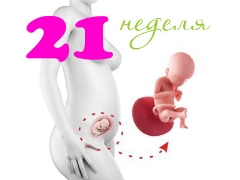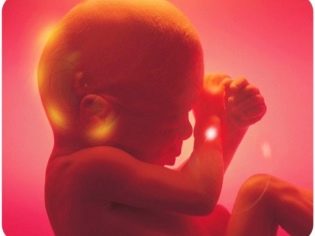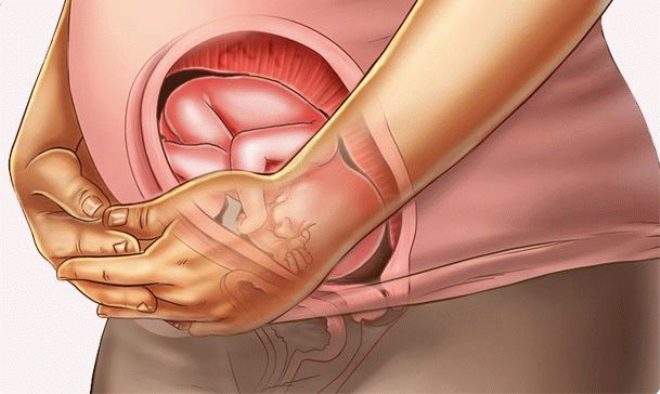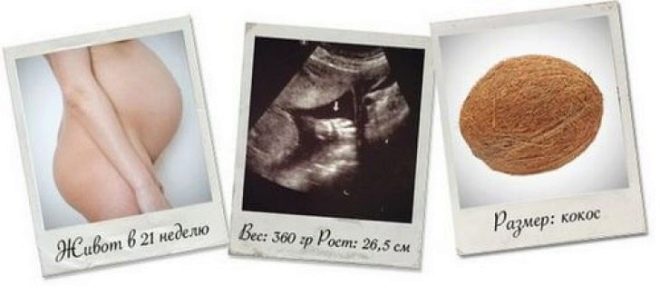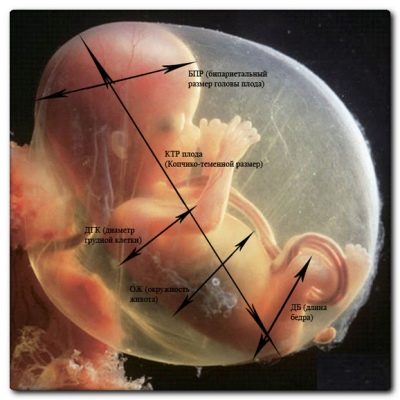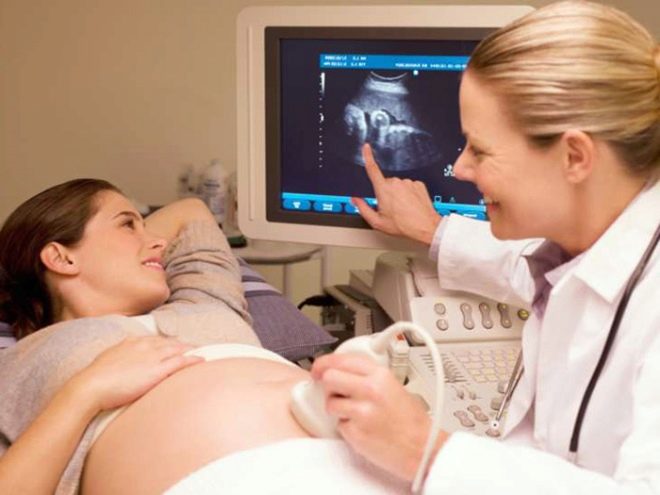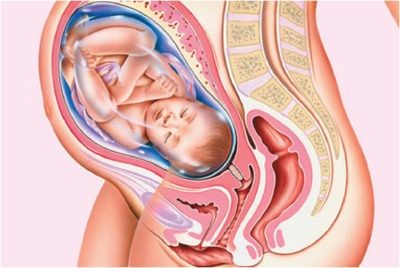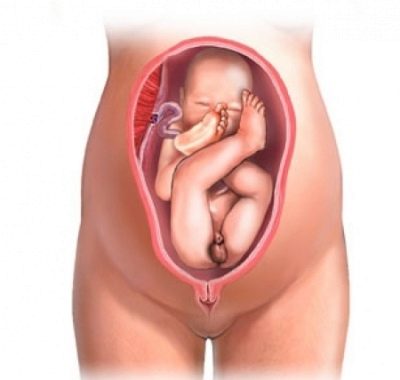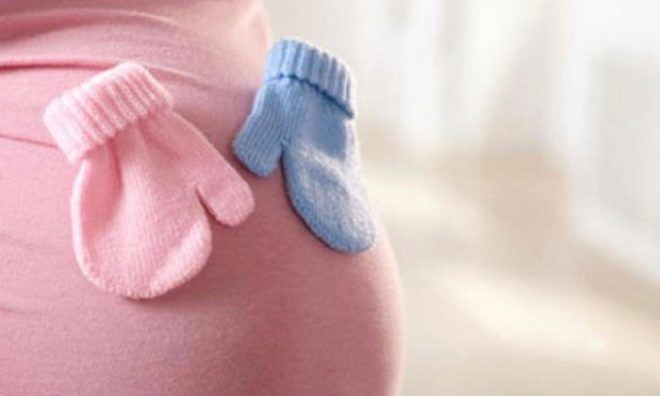Fetal development in the 21st week of pregnancy
Each week of pregnancy is accompanied by a number of interesting events that occur in the body of a growing baby. Fetal development continues at week 21. 21 weeks of pregnancy is a kind of milestone in the intrauterine development of the baby. By this date, the child has already formed many important vital organs, as well as nerve analyzers, through which he will learn the world. The first sensations of the fetus.
Hearing
At this stage of pregnancy, the fetus has the ability to hear various sounds. It is important to note that these are only the beginnings of hearing. The fetus cannot yet understand and analyze speech, since its brain is not yet sufficiently developed for this. However, the baby can hear different sounds and even recognize the voices of his parents. Numerous scientific studies have shown that the voice of his mother has a calming effect on the baby.
Too loud and annoying sounds contribute to the fact that the baby begins to push or move strongly in my mother's tummy, pleasant melodies, on the contrary, improve the baby’s well-being and positively influence the development of his nervous system.
Experts recommend future parents to conduct "dialogues" with their baby. You can tell a child fairy tales, talk with him. Of course, the baby still does not understand the speech he heard, but a beneficial effect on his nervous system will be provided.
There are scientific studies confirming that Regular conversations with the child, who is still in the womb, have a positive effect on the formation of the psycho-emotional connection between the mother and the baby.
Vision
Despite the formed eye sockets and even eyeballs, the baby really cannot see yet. However, he is already able to distinguish between different bright flashes of light. For example, scientists have noticed that when the lamp shines brightly on the face of a child, even through the belly, he immediately turns away from the blinding rays.
Outside, the palpebral fissure covers the eyelids. Their skin is very thin and delicate. The size of the eye and eyelid still disproportionate. When the eyelids strongly cover the eyes of the baby, it seems that the child is sleeping.
Taste
In the language of the child, there are already special microscopic processes - the nipples. It is thanks to them that he is able to distinguish between different tastes. The baby can do this only by swallowing the amniotic fluid.
It should be noted that the amniotic fluid may have different tastes. On one day it is a sweet and quite pleasant liquid, on the other a salty, which can be a little bitter. The taste of amniotic fluid is largely influenced by the food that the expectant mother eats.
The child, swallowing a small amount of amniotic fluid, is able to recognize their taste. In some cases, he likes the baby, but in others, on the contrary, it is unpleasant.
Scientists note that the fetus is able to swallow about 400 ml of amniotic fluid during the day. This process contributes to the fact that the amniotic fluid is constantly updated. Ingestion of fluid, and then its release, is the most important stage in the development of the urinary system of the baby.
First movements
Intensive development of the musculoskeletal system and the work of the nervous system contribute to the fact that the fetus appears motor activity. The kid not only moves his hands or bends his legs, but also begins to turn his head. Also, the fruit is able to roll over.
The baby may be repelled by the walls of the uterus. Such active movements, as a rule, are already quite clearly felt by a pregnant woman. The more active the baby, the brighter it feels his mother.
Often, the first movements of the fetus pregnant women attach too much importance. Of course, the motor activity of the baby is very important, but still it is not a determining factor in the physiological course of fetal development.
Some babies can be quite calm by nature, which later, as a rule, manifests itself in their character after birth. Others are fidgets. Even during its prenatal development, the restless baby causes quite a lot of anxiety to its mother, constantly kicking in her stomach.
A huge variety of all kinds of factors, ranging from the diet of the expectant mother to complex pathologies, affect the motor activity of the baby.
It is very important that an experienced and qualified doctor supervise the course of pregnancy. It is he who will be able to assess whether the baby’s motor activity is normal and whether there are any pathologies.
Body parameters
Every day, the baby, who "lives" in my mother's belly, grows and develops. Experts often compare the fruit with some object or fruit. This makes it possible for expectant mothers to imagine what size their baby is at a certain period of intrauterine development. Fetus at 21 weeks gestation can be compared with a fairly large banana.
The most important indicators of the intensity of prenatal development of a child are considered the basic parameters of his body - weight and height. These indicators are necessarily measured during the ultrasound examination. The normal values of the basic parameters of the baby at the 21st week of pregnancy are presented in the table below.
Clinical sign of the fetus | Norm |
Growth | 26-30 cm |
Weight | 370-450 grams |
The method that allows you to estimate the size of the fetus is called fetometry. At its core, this is a specific ultrasound examination. When conducting such a survey, in addition to the height and weight of the baby, the specialist determines other clinical criteria. One of them is the biparient size (bpr). At this stage of pregnancy, its rate is 4.5-5.6 cm. The remaining parameters studied, which are also determined during the survey, are presented in the table below.
Investigated Criterion | Normal value at 21 weeks gestation |
Frontal-nuchal size | 6.1-7 cm |
Head circumference | 16.7-20 cm |
Tummy circumference | 13.8-17.6 cm |
Femur bone length | 3.2-4 cm |
Humerus length | 3-3.7 cm |
Forearm Bone Length | 2.4-3.3 cm |
Bone length of shin | 2.9-3.7 cm |
It should be noted that the expectant mother should not panic if her baby weighs slightly less than it should be at its age. The parameters of the body depend on many factors, some of which are not at all a consequence of pathology.
Only a doctor who monitors the development of a specific pregnancy can determine abnormalities in the prenatal development of a baby. Such an assessment is carried out in a comprehensive manner, and not only for any one value obtained of the conducted fetometry.
Location in the womb
During its prenatal development, the baby may be located in the uterus in different ways. It is important to note that before the birth, he may change his position several times from 20-21 obstetric weeks. This usually happens with restless babies or in the presence of certain pathologies during pregnancy.
The most favorable option for the location of the fetus, doctors believe the headache. In this case, the head of the child is facing the entrance to the pelvis.With this option, the location of the fetus its birth, as a rule, occurs physiologically - naturally and without any complications. During labor, the head passes through the birth canal, followed by other parts of the body. In this case, childbirth, as a rule, proceed safely.
A less favorable option is pelvic presentation. In this situation, not the head of the fetus, but its pelvic end is located at the entrance to the small pelvis.
Independent natural birth of a baby with such a presentation is fraught with the development of various pathologies, including very severe ones. Perinatal mortality of babies with pelvic presentation at the present time, unfortunately, still remains quite high. To prevent the risk of possible complications during childbirth, doctors with pelvic presentation of the fetus prefer cesarean section.
Appearance
A child who "lives" in the belly of his mother, already looks like a real man, but only very small. He can already distinguish individual features - a flat forehead, a tiny nose, cheeks, chin. Fetal arches are even formed on the fetus.
On the sides of the face are small ears, which are located close enough to the neck. On the torso and on the head of the baby there are very thin, fluffy hair. Also, he has already formed small cilia. Eyes outside are covered with thin eyelids.
The proportion of the body of the fetus is also gradually changing. So, his head no longer looks huge. The limbs continue to change. Each hand and foot has small fingers with marigolds.
The skin of the fetus outside is covered with a special substance - the original lubricant. The secretion of sweat and sebaceous glands, mixed with desquamated epithelium, participates in its formation. Original grease usually has a light yellowish tint.
Is it possible to determine the sex of the child?
Find out whether a boy or a girl will be born, at this time it is already possible It is very important that such a study be carried out by an experienced specialist - in this case, the probability of error is somewhat reduced. In case of multiple pregnancies, a specialist should determine the sex of each of the babies separately.
The possibility of determining sex is largely due to the fact that the fetus by this time its intrauterine life has already formed the main genital organs. The boys even formed the prostate gland, and the girls already have eggs.
About what happens to mother and baby in the 21st week of pregnancy, see the next video.
